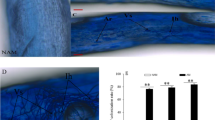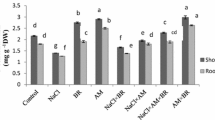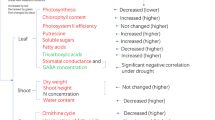Abstract
Sophora davidii is an important leguminous scrub that is widely used for revegetation in the semiarid Loess Plateau and other arid valley areas of China, where it usually suffers drought stress. This study investigated the effects of arbuscular mycorrhizal (AM) fungi (Glomus mosseae and Glomus constrictum) and water stress on the growth and physiological performance of S. davidii seedlings under greenhouse pot conditions. Two soil water availability treatments (well-watered (WW) −0.10 MPa; water-stressed (WS) −0.86 MPa) were applied for 61 days. At the end of this experiment, G. mosseae and G. constrictum had colonized the roots of S. davidii seedlings. Water stress inhibited AM colonization, plant growth, chlorophyll concentration, gas exchange and chlorophyll fluorescence of S. davidii seedlings. Mycorrhizal seedlings had greater shoot dry weight, root dry weight, plant height, root length, instantaneous water use efficiency (iWUE), net photosynthetic rate (Pn), stomatal conductance (gs), maximal photochemical efficiency of PSII photochemistry (Fv/Fm), lower intercellular CO2 concentration and photochemical quenching values (qP), when compared with non-mycorrhizal seedlings under both WW and WS conditions. Furthermore, G. constrictum was found to be more efficient at improving the shoot and root mass, plant height, iWUE, Pn, gs, qP, and ΦPSII of S. davidii seedlings, when compared with G. mosseae under both WW and WS conditions. Our results demonstrate that AM Glomus symbiosis enhanced S. davidii seedling resistance by improving its growth and physiological performance under water stress conditions. This suggests that Glomus inoculation is a potential tool for enhancing outplanting performance of S. davidii in semiarid areas of China.

Similar content being viewed by others
References
Aggangan NS, Moon HK, Han SH (2010) Growth response of Acacia mangium Willd. seedlings to arbuscular mycorrhizal fungi and four isolates of the ectomycorrhizal fungus Pisolithus tinctorius (Pers.) Coker and Couch. New For 39:215–230
Allen MF, Boosalis MG (1983) Effects of two species of VA mycorrhizal fungi on drought tolerance of winter wheat. New Phytol 93:67–76
Augé RM, Scheckel KA, Wample RL (1986) Greater leaf conductance of well-watered VA mycorrhizal rose plants is not related to phosphorus nutrition. New Phytol 103:107–116
Barrs HD, Weatherley PE (1962) A re-examination of the relative turgidity technique for estimating water deficits in leaves. Aust J Biol Sci 15:413–428
Bethlenfalvay GJ, Brown MS, Franson RL (1990) The Glycine-Glomus-Bradyrhizobium symbiosis, X relationships between leaf gas exchange and plant and soil water status in nodulated, mycorrhizal soybean under drought stress. Plant Physiol 94:723–728
Caravaca F, Alguacil MM, Figueroa D, Barea JM, Roldán A (2003) Re-establishment of Retama sphaerocarpa as a target species for reclamation of soil physical and biological properties in a semi-arid Mediterranean area. For Ecol Manage 182:48–58
Faber BA, Zasoski RJ, Munns DN, Shackel K (1991) A method for measuring hyphal nutrient and water uptake in mycorrhizal plants. Can J Bot 69:87–94
Feng XX, Tang M, Gong MG, Yu HX (2011) Spatial distribution of arbuscular mycorrhizal and glomalin in the rhizosphere of Sophora davidii on the Loess Plateau. J Northwest Sci Tech Univ Agric For (Nat Sci Ed) 39:96–102 (in Chinese)
Giovannetti M, Mosse B (1980) An evaluation of techniques for measuring vesicular arbuscular mycorrhizal infection in roots. New Phytol 84:489–500
Goicoechea N, Merino S, Sánchez-Díaz M (2005) Arbuscular mycorrhizal fungi can contribute to maintain antioxidant and carbon metabolism in nodules of Anthyllis cytisoides L. subjected to drought. J Plant Physiol 162:27–35
Huang Z, Zou ZR, He CX, He ZQ, Zhang ZB, Li JM (2011) Physiological and photosynthetic responses of melon (Cucumis melo L.) seedlings to three Glomus species under water deficit. Plant Soil 339:391–399
Hura T, Hura K, Grzesiak M, Rzepka A (2007) Effect of longterm drought stress on leaf gas exchange and fluorescence parameters in C3 and C4 plants. Acta Physiol Plant 29:103–113
Kramer PJ, Boyer JS (1995) Water relations of plants and soils. Academic Press, San Diego
Li FL, Bao WK, Wu N (2009) Effects of water stress on growth, dry matter allocation and water-use efficiency of a leguminous species, Sophora davidii. Agrofor Syst 77:193–201
Marques MS, Pagano M, Scotti MRMML (2001) Dual inoculation of a woody legume (Centrolobium tomentosum) with rhizobia and mycorrhizal fungi in south-eastern Brazil. Agrofor Syst 52:107–117
Maxwell K, Johnson GN (2000) Chlorophyll fluorescence—a practical guide. J Exp Bot 51:659–668
Muthukumar T, Udaiyan K (2010) Growth response and nutrient utilization of Casuarina equisetifolia seedlings inoculated with bioinoculants under tropical nursery conditions. New For 40:101–118
Phillips JM, Hayman DS (1970) Improved procedure for clearing roots and staining parasitic and vesicular-arbuscular mycorrhizal fungi for rapid assessment of infection. Trans Br Mycol Soc 55:158–161
Requena N, Jimenez I, Toro M, Barea JM (1997) Interactions between plant-growth-promoting rhizobacteria (PGPR), arbuscular mycorrhizal fungi and Rhizobium spp. in the rhizosphere of Anthyllis cytisoides, a model legume for revegetation in Mediterranean semi-arid ecosystems. New Phytol 136:667–677
Requena N, Pérez-Solís E, Azcón-Aguilar C, Jeffries P, Barea JM (2001) Management of indigenous plant-microbe symbioses aids restoration of desertified ecosystems. Appl Environ Microbiol 67:495–498
Richards LA (1941) A pressure-membrane extraction apparatus for soil solution. Soil Sci 51:377–386
Ruiz-Lozano JM (2003) Arbuscular mycorrhizal symbiosis and alleviation of osmotic stress. New perspectives for molecular studies. Mycorrhiza 13:309–317
Ruiz-Lozano JM, Azcón R (1995) Hyphal contribution to water uptake in mycorrhizal plants as affected by the fungal species and water status. Physiol Plant 95:472–478
Ruiz-Lozano JM, Gómez M, Azcón R (1995) Influence of different Glomus species on the time-course of physiological plant responses of lettuce to progressive drought stress periods. Plant Sci 110:37–44
Ruiz-Sánchez M, Aroca R, Muñoz Y, Polón R, Ruiz-Lozano JM (2010) The arbuscular mycorrhizal symbiosis enhances the photosynthetic efficiency and the antioxidative response of rice plants subjected to drought stress. J Plant Physiol 167:862–869
Sánchez-Díaz M, Pardo M, Antolín M, Peña J, Aguirreolea J (1990) Effect of water stress on photosynthetic activity in the Medicago-Rhizobium-Glomus symbiosis. Plant Sci 71:215–221
Smith SE, Read DJ (1997) Mycorrhizal symbiosis, 2nd edn. Academic Press, London
Souza BD, Meiado MV, Rodrigues BM, Santos MG (2010) Water relations and chlorophyll fluorescence responses of two leguminous trees from the Caatinga to different watering regimes. Acta Physiol Plant 32:235–244
Subramanian KS, Charest C, Dwyer LM, Hamilton RI (1995) Arbuscular mycorrhizas and water relations in maize under drought stress at tasseling. New Phytol 129:643–650
Victoria A, Borowicz (2010) The impact of arbuscular mycorrhizal fungi on strawberry tolerance to root damage and drought stress. Pedobiologia 53:265–270
Wu FZ, Bao WK, Li FL, Wu N (2008a) Effects of drought stress and N supply on the growth, biomass partitioning and water-use efficiency of Sophora davidii seedlings. Environ Exp Bot 63:248–255
Wu QS, Xia RX, Zou YN (2008b) Improved soil structure and citrus growth after inoculation with three arbuscular mycorrhizal fungi under drought stress. Eur J Soil Biol 44:122–128
Acknowledgments
This study was funded by the Key Project of the National Natural Science Foundation of China (30730073, 31170567), the Program for Changjiang Scholars and Innovative Research Team in the University of China (IRT1035) and the Doctoral Program of Higher Education of China (20100204110033, 20110204130001). We also thank anonymous reviewers for their valuable suggestion to enhance the manuscript and Dr Duncan E. Jackson for improving the English language used in this manuscript.
Author information
Authors and Affiliations
Corresponding author
Rights and permissions
About this article
Cite this article
Gong, M., Tang, M., Chen, H. et al. Effects of two Glomus species on the growth and physiological performance of Sophora davidii seedlings under water stress. New Forests 44, 399–408 (2013). https://doi.org/10.1007/s11056-012-9349-1
Received:
Accepted:
Published:
Issue Date:
DOI: https://doi.org/10.1007/s11056-012-9349-1




